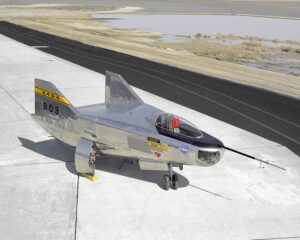12 July 1966 – “A lifting body is a fixed-wing aircraft or spacecraft configuration in which the body itself produces lift. In contrast to a flying wing, which is a wing with minimal or no conventional fuselage, a lifting body can be thought of as a fuselage with little or no conventional wing. Whereas a flying wing seeks to maximize cruise efficiency at subsonic speeds by eliminating non-lifting surfaces, lifting bodies generally minimize the drag and structure of a wing for subsonic, supersonic and hypersonic flight, or spacecraft re-entry.”(2) The US built a number of lifting body rocket planes to test the concept, as well as several rocket-launched re-entry vehicles that were tested over the Pacific.
 The Northrop M2-F2 was a heavyweight lifting body based on studies at NASA’s Ames and Langley research centers and built by the Northrop Corporation in 1966.
The Northrop M2-F2 was a heavyweight lifting body based on studies at NASA’s Ames and Langley research centers and built by the Northrop Corporation in 1966.
The success of Dryden’s M2-F1 program led to NASA’s development and construction of two heavyweight lifting bodies based on studies at NASA’s Ames and Langley research centers—the M2-F2 and the HL-10, both built by the Northrop Corporation. The “M” refers to “manned” and “F” refers to “flight” version. “HL” comes from “horizontal landing” and 10 is for the tenth lifting body model to be investigated by Langley.
The M2-F2 made its first captive flight (attached to the B-52 carrier aircraft throughout the flight) on March 23, 1966.
The first flight of the M2-F2 – which looked much like the M2-F1 – was on July 12, 1966. Milton O. Thompson was the pilot.
By then, the same B-52 used to air launch the famed X-15 rocket research aircraft was modified to also carry the lifting bodies. Thompson was dropped from the B-52’s wing pylon mount at an altitude of 45,000 feet (13,700 m) on that maiden glide flight. He reached a gliding speed of about 450 miles per hour (720 km/h).”(1)
Source: (1) Wikipedia (M2-F2) and (2)Wikipedia (Lifting Body)
